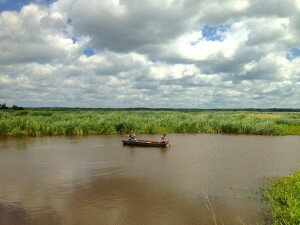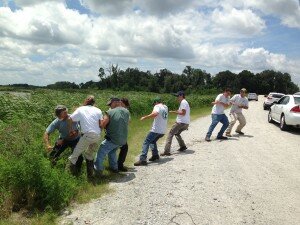 Savannah National Wildlife Refuge is located in the heart of Lowcountry, a band of low land between South Carolina and Georgia, and one of seven refuges administered within the Savannah Coastal Refuge Complex. The visitor services manager at Savannah had been out the week before, and wasn’t sure our team was still planning to stop by. You can imagine her surprise when she called to see how the trip was going, and I replied that we were enjoying the 4-mile long Savannah Wildlife Drive that morning! If anyone has met Monica Harris, then you know she’s able to pull off almost anything in a pinch. Within 20 minutes, between our conversation and pulling into the visitor center, she had called two interns and a retiree from the refuge to come fishing with us.
Savannah National Wildlife Refuge is located in the heart of Lowcountry, a band of low land between South Carolina and Georgia, and one of seven refuges administered within the Savannah Coastal Refuge Complex. The visitor services manager at Savannah had been out the week before, and wasn’t sure our team was still planning to stop by. You can imagine her surprise when she called to see how the trip was going, and I replied that we were enjoying the 4-mile long Savannah Wildlife Drive that morning! If anyone has met Monica Harris, then you know she’s able to pull off almost anything in a pinch. Within 20 minutes, between our conversation and pulling into the visitor center, she had called two interns and a retiree from the refuge to come fishing with us.
When we drove back on the Wildlife Drive, our crew had grown to an additional 3 YCC crew members, and Greg Blanks, the Law Enforcement officer. We started filming on one of the impoundments, and had the crew casting from the bank as well as fishing in a small johnboat.
 Alligators are a common sight around the Savannah refuge, and we saw one hanging around as we were filming. This alligator, however, responded eagerly when grass was thrown towards it and for anyone who knows a thing or two about alligators; that’s a bad sign. Typically alligators are cautious around humans, but when fed by people they can become accustomed to it. Nuisance alligators, as they are called, lose their fear of humans and can cause problems for visitors, including fishermen. Harris and Blanks had both received previous calls about this prowling gator, and decided with our film crew here it might be a good time to relocate him and document the story. This way, visitors can see the repercussions of feeding alligators.
Alligators are a common sight around the Savannah refuge, and we saw one hanging around as we were filming. This alligator, however, responded eagerly when grass was thrown towards it and for anyone who knows a thing or two about alligators; that’s a bad sign. Typically alligators are cautious around humans, but when fed by people they can become accustomed to it. Nuisance alligators, as they are called, lose their fear of humans and can cause problems for visitors, including fishermen. Harris and Blanks had both received previous calls about this prowling gator, and decided with our film crew here it might be a good time to relocate him and document the story. This way, visitors can see the repercussions of feeding alligators.
They called in resident Trapper Jack Douglas. Trapper Jack and his daughter led the team, which included our entire entourage, to trap and hog-tie the alligator. Many visitors, from as far away as Belgium, stopped in awe and asked questions about what they were seeing. Blanks, who is accustomed to answering visitor inquires, described the purpose of this alligator relocation effort and how detrimental it is to feed alligators on National Wildlife Refuges, or anywhere in the wild. 
My take-home from today was not only can we never plan for what might happen on a refuge, but more importantly, refuges are the home to animals, plants and fish. In their world, we are the visitors, and we must respect their boundaries. And remember: Don’t feed wild animals!
![]()
![]()
![]()
![]()
![]()
 Anna Harris is the Vision Coordinator for Conserving the Future and a member of the team taking vision on the road.
Anna Harris is the Vision Coordinator for Conserving the Future and a member of the team taking vision on the road.



2 Comments in this post »
RSS feed for comments on this post. | TrackBack URL
Monica does well at her job, I commend her work, doing customer service. Having returning staff with great past experiences in the field is very beneficial to a wildlife park. Remembering that a refuge or wildlife park is a home for an animal is important to keep in mind. When we feed the wildlife, they become more accustomed to people and are more likely to approach any person thinking that the humans have food. This animal mind set, highly relatable to Pavlov’s study of classical conditioning, can present a danger as well. It is unpredictable what any animals might do to get food or humans might do to protect themselves.
Others state that the bill should require not just
a hunter over the age of 21 but the parents themselves should be required to be present.
Of these types of functions would be the opportunity to record what you.
Wolves and dogs look for something in other animals called “prey-worthiness”.